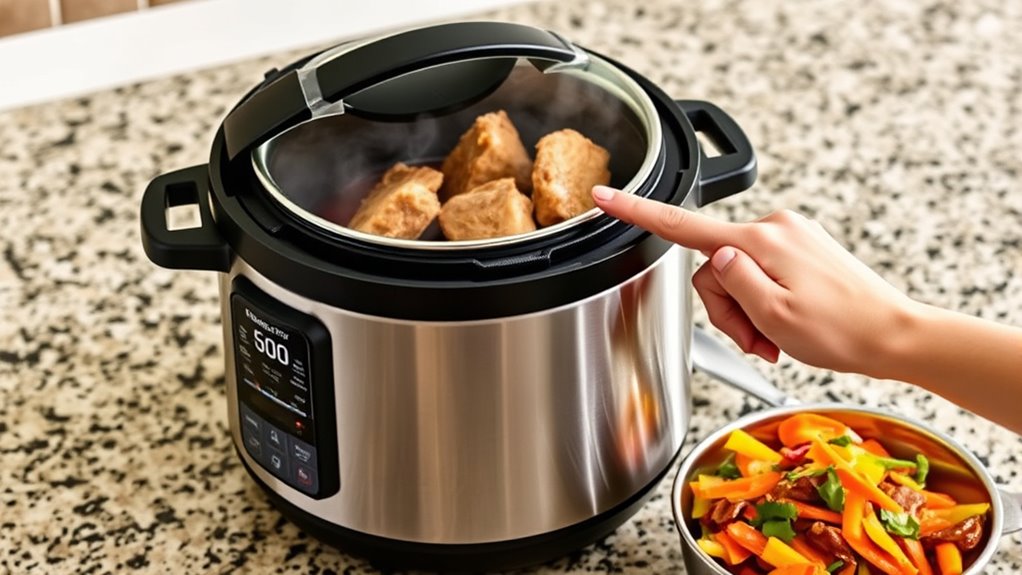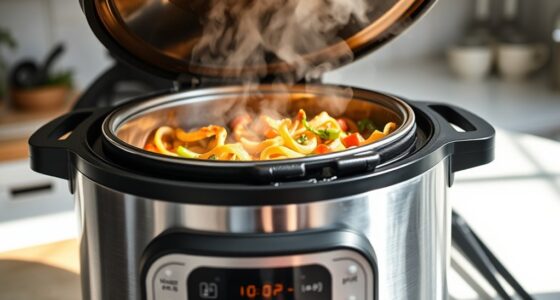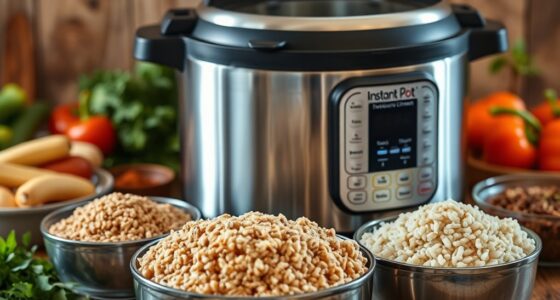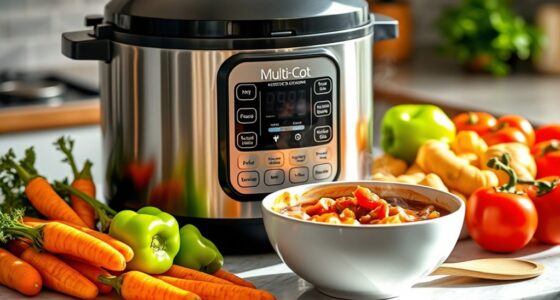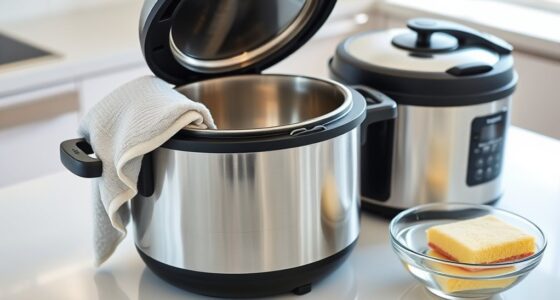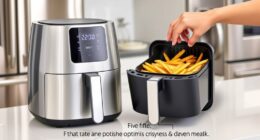To make the most of your multicooker, start by using the slow cook function for deep flavors and tender dishes. When you need quick results, switch to pressure cooking or searing to brown meats directly in the pot, saving time and extra pans. Use steaming for vegetables and baking for bread or desserts. Exploring these versatile functions helps you create complete meals with less effort. Keep exploring to reveal even more culinary possibilities.
Key Takeaways
- Understand your multicooker’s pre-set programs for slow cooking, searing, and other functions to maximize versatility.
- Use the sear function to brown meats before slow cooking or pressure cooking for enhanced flavor.
- Combine functions, such as searing first, then switching to slow cook, to develop depth in dishes.
- Utilize the delay timer and keep-warm features for convenient, multi-stage meal preparation.
- Clean the cooker thoroughly between functions to maintain performance and prevent flavor transfer.

Ever wondered how a single appliance can handle so many cooking tasks? A multicooker is truly a game-changer in your kitchen, offering unmatched recipe versatility and cooking convenience. Instead of juggling multiple pots, pans, and appliances, you get a single device that can sauté, slow cook, pressure cook, steam, bake, and even sear. This multifunctionality means you can prepare a complete meal from start to finish without the clutter or complexity of traditional cooking methods. With just one device, you can switch seamlessly between functions, saving time and effort while expanding your culinary options.
A multicooker simplifies cooking with endless functions in one versatile, space-saving device.
One of the biggest advantages of a multicooker is its ability to adapt to different recipes and cooking styles. Want to make a hearty stew? Set it to slow cook and let it simmer for hours, developing deep flavors. Craving a quick, tender chicken dish? Switch to pressure cook mode, reducing cooking time without sacrificing tenderness. Feel like baking bread or making rice? The baking or steaming functions have you covered. This recipe versatility allows you to experiment and create a variety of dishes, from breakfast to dinner and even desserts, all in one appliance. It’s like having multiple appliances in one compact device, which not only saves space but also simplifies meal prep.
Cooking convenience is another key benefit. Multicookers often come with pre-set programs, so you don’t need to monitor every step. You can set it and forget it, freeing up your time to focus on other tasks or relax. Plus, many models feature delay timers and keep-warm functions, ensuring your meal stays hot until you’re ready to eat. The ability to sear meat directly in the cooker before slow cooking or pressure cooking adds even more convenience, eliminating the need for extra pans and dishes. This one-pot approach reduces cleanup and streamlines your workflow, making everyday cooking less stressful. Additionally, the integration of multifunctional cooking features enhances efficiency by consolidating tasks that traditionally required multiple appliances.
Furthermore, a multicooker’s user-friendly interface and programmable settings make it accessible for cooks of all skill levels. Whether you’re an experienced chef or a beginner, you can easily navigate its functions and produce consistently delicious results. The appliance’s versatility also encourages healthier eating, as you can control ingredients and cooking methods more precisely. From browning onions to steaming vegetables or braising meats, this appliance adapts to your needs and preferences. Overall, a multicooker transforms your kitchen experience, combining recipe versatility with unmatched cooking convenience, giving you the freedom to create more dishes with less effort.
Frequently Asked Questions
Can I Use My Multicooker for Baking Bread?
Yes, you can use your multicooker for bread baking and dough proofing. Many models have a baking or yogurt setting that’s perfect for proofing dough, ensuring a warm, steady temperature. For bread baking, select the bake function if available, or use the slow cook setting with the lid off to develop a crust. Always follow your multicooker’s manual for best results and avoid overloading.
How Do I Adjust Cooking Times for Different Recipes?
Imagine your multicooker is throwing a temper tantrum because you didn’t give it precise instructions. To avoid this, you’ll need to make recipe modifications and timing adjustments. Start by consulting the recipe’s recommended times and then tweak them based on your cooker’s quirks. Keep an eye on your dish, and don’t be afraid to experiment—your multicooker appreciates a little guidance, even if it doesn’t always show it.
Is It Safe to Leave My Multicooker Unattended?
Leaving your multicooker unattended can be safe if you follow proper safety precautions. Always use the appliance on a stable surface, stay nearby, and avoid overfilling it. Modern multicookers often have safety features like auto shut-off and pressure release, which help prevent accidents. However, you should still monitor cooking when possible, especially for longer recipes, to make certain safety and prevent potential issues from unattended cooking.
Can I Cook Frozen Ingredients Directly in the Multicooker?
Did you know that over 60% of people cook with frozen ingredients? You can cook frozen ingredients directly in your multicooker, but it’s essential to prioritize cooking safety. make certain you add extra cooking time, and always check that foods reach the proper internal temperature before serving. This helps prevent bacteria growth and guarantees your meal is safe and delicious. Always follow your multicooker’s guidelines for frozen foods to avoid mishaps.
What Maintenance Is Required for Multicooker Functions?
You should regularly perform cleaning cycles on your multicooker to prevent buildup and guarantee ideal performance. Make sure to follow the manufacturer’s instructions for cleaning, especially around the heating element and lid. Additionally, check and calibrate the buttons periodically to keep them responsive. Proper maintenance involves cleaning, calibration, and inspecting seals and valves, which helps extend your multicooker’s lifespan and keeps all functions working smoothly.
Conclusion
Don’t shy away from exploring your multicooker’s full potential. Even if you think it’s only good for slow cooking, trying out searing or steaming can elevate your dishes. Yes, it might seem complicated at first, but with a little practice, you’ll see how easy and versatile it is. So go ahead—embrace all the functions and transform simple ingredients into impressive meals. You’ll wonder why you didn’t start sooner!
